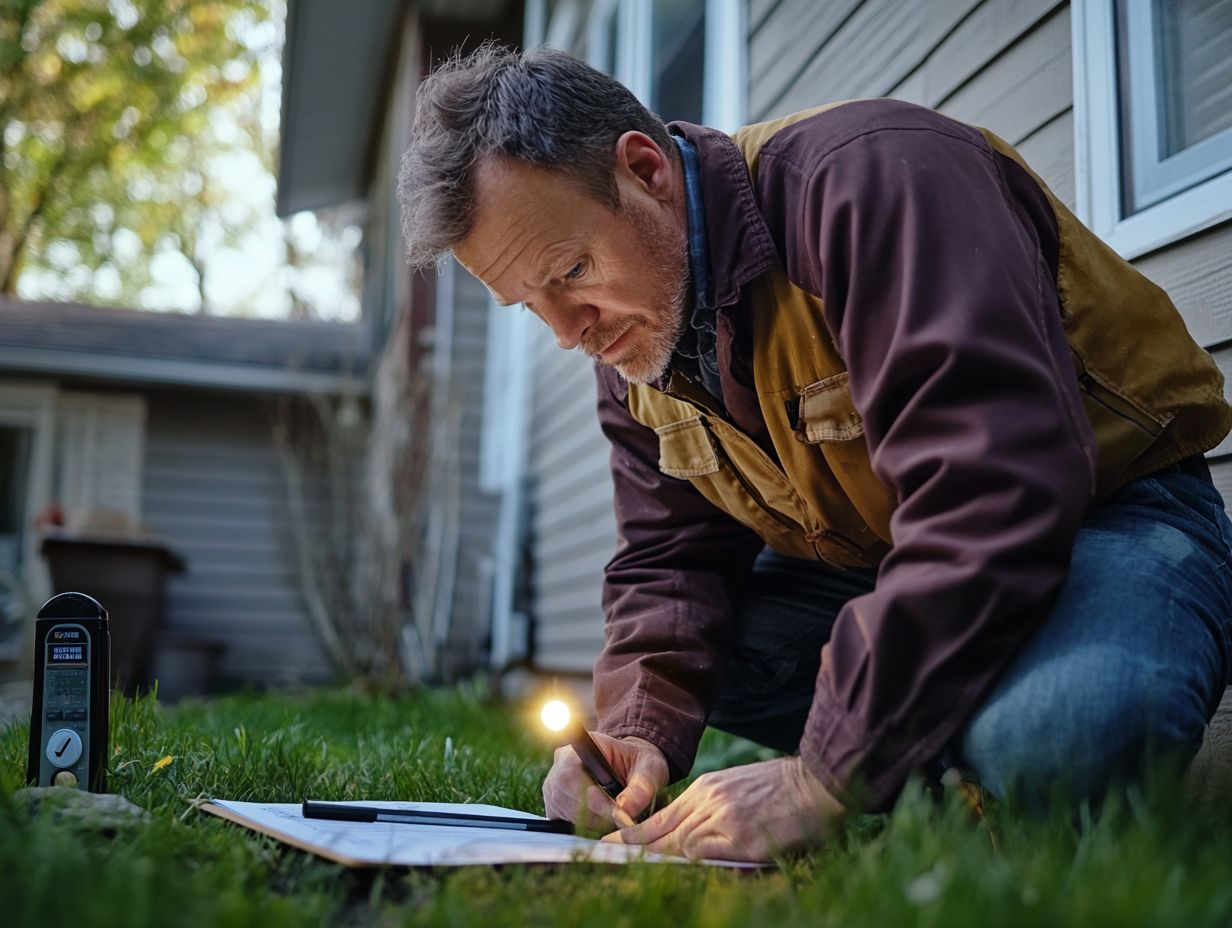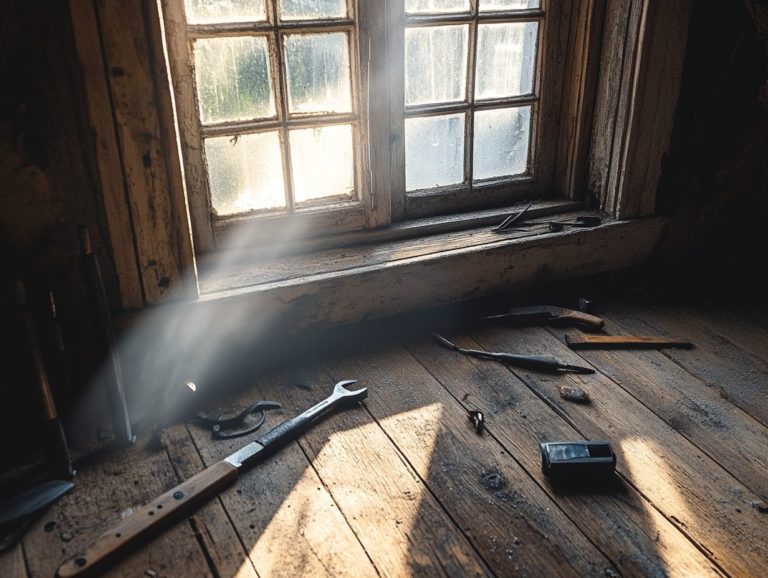Key Elements of a Comprehensive Home Inspection
Purchasing a home ranks among life s most significant investments. Home inspections are indispensable for your peace of mind and financial security.
This article delves into the essential components of a comprehensive home inspection. It guides you through evaluating the exterior think roofs and foundations while also addressing vital interior systems like plumbing and electrical.
Structural integrity and additional assessments can protect you from hidden risks. Whether you re a buyer or a seller, grasping these elements will pave the way for a smoother transaction and a safer home.
Contents
- Home Inspection Guide
- Siding and Foundation
- Interior Inspection
- Structural Inspection
- Frequently Asked Questions
- What are the key elements of a comprehensive home inspection?
- Why is a comprehensive home inspection important?
- Who typically does a comprehensive home inspection?
- How long does a comprehensive home inspection typically take?
- What can you expect after a comprehensive home inspection?
- Can I attend the home inspection?
Key Takeaways:

A comprehensive home inspection is necessary to identify potential issues and ensure the safety and value of a property.
The exterior inspection should cover the roof, gutters, siding, and foundation. For a comprehensive evaluation, it’s crucial to understand the importance of a thorough home inspection, which includes focusing on plumbing, electrical, heating, and cooling systems during the interior inspection.
Structural inspections should include walls, floors, ceilings, windows, and doors. For a comprehensive overview, knowing what to expect during a home inspection can help you identify if additional inspections for pests, mold, radon, and lead are also necessary.
The Importance of Home Inspections
Home inspections are integral to the real estate journey. They act as a vital resource for both buyers and sellers.
These inspections give you a clear picture of what you’re buying or selling. They offer a detailed evaluation of a property’s condition and reveal potential issues that might not be immediately apparent.
By engaging a professional inspector, you can make informed decisions that protect your investment. Sellers have the opportunity to tackle any concerns upfront, enhancing their home’s appraisal and easing negotiations.
A comprehensive home inspection report is a valuable tool in the intricate dance of buying and selling a home, and understanding the basics of home inspections can make the process smoother.
Why They are Necessary
Home inspections are essential for uncovering safety issues and potential problems. These assessments serve a dual purpose, acting as a safeguard for both buyers and sellers.
By revealing underlying safety concerns such as electrical hazards, plumbing leaks, or foundational issues you can make informed decisions and sidestep costly repairs in the future.
For sellers, this is a golden opportunity to tackle these issues before listing the home. Ultimately, this boosts its value.
A thorough inspection can also lead to better negotiation outcomes. When buyers are aware of potential concerns, they can use these insights to secure more favorable terms.
In essence, home inspections not only enhance transparency but also foster trust throughout the real estate transaction process.
Exterior Inspection
The exterior inspection is a crucial element in the home inspection process. You’ll find an in-depth evaluation of various structural components that determine the property’s durability and performance, including the top 10 things to check during a home inspection.
During this phase, inspectors will carefully examine the roof for any damages. They will inspect the gutters for potential blockages and examine the siding and foundation for signs of wear or structural concerns.
Utilizing a detailed inspection checklist ensures a comprehensive evaluation. This enables both buyers and sellers to fully grasp the property’s condition and can help them understand the home inspection process to address any necessary repairs or upgrades.
Roof and Gutters
A thorough inspection of your roof and gutters is essential for spotting potential problems. These issues could escalate into serious safety concerns and costly repairs.
During this inspection, you ll want to pay close attention to key factors like signs of wear, water damage, and any blockages.
Inspectors meticulously evaluate roofing materials for cracks or missing shingles that might allow moisture to sneak in. They also examine the gutters for any debris buildup that could lead to overflow and water pooling, conditions that might compromise your foundation.
By addressing these issues promptly, you not only protect the structural integrity of your residence but also enhance its overall lifespan.
Doing so ensures a safe and comfortable environment for your family.
Home Inspection Guide
Siding and Foundation

The siding and foundation are key structures of your home. They require careful inspection to ensure everything is intact.
Watch for visible cracks in the foundation; they may indicate shifting soil or poor support. Also, keep an eye out for rotting siding it can lead to water damage.
Regularly check these areas to catch problems early. Doing so protects the overall health of your property!
Interior Inspection
The interior inspection is crucial for assessing important systems like plumbing, electrical, and heating. This evaluation ensures these systems run safely and efficiently.
For buyers, this offers critical insight into the property’s condition. It also helps identify repairs before finalizing the purchase.
Plumbing and Electrical Systems
Evaluating plumbing and electrical systems is essential for safety. It’s easy to overlook minor leaks or frayed wires, but these can become serious hazards.
Don’t ignore those leaks! Fixing them now can save you from costly repairs later. Leaks may cause water damage and mold, while old wiring can lead to fires.
Conduct regular assessments to catch issues early.
Heating and Cooling Systems
Your heating, ventilation, and air conditioning (HVAC) system is vital for comfort. Inspecting it helps uncover issues that could lead to safety problems or higher bills.
Inspectors check the ducts, thermostats, and electrical connections. Common issues like refrigerant leaks need prompt attention.
Structural Inspection
A structural inspection focuses on walls, floors, and ceilings to ensure stability. This evaluation gives you a clear picture of the home’s condition.
Finding structural issues early helps avoid costly repairs later on. It can also significantly increase your property’s value!
Walls, Floors, and Ceilings

Inspecting the walls, floors, and ceilings in your home is essential for identifying potential problems that could lead to serious safety issues.
These inspections go beyond mere aesthetics; they act as a proactive measure to uncover hidden defects like cracks, water damage, or signs of mold that could compromise structural integrity. By paying close attention to areas where materials may be separating or sagging, you can gain valuable insight into underlying issues that might otherwise slip under the radar.
Early detection of these concerns saves you from costly repairs and ensures that your living environment remains safe and sound. Neglecting even minor damage can escalate into major headaches. Maintaining vigilance during these assessments is crucial for preserving the overall safety of your home.
Windows and Doors
Evaluating your windows and doors is essential during a home inspection, as these elements are key structural components that significantly influence both security and energy efficiency.
If you overlook their condition, you may expose yourself to a range of common issues, such as drafts that compromise indoor comfort and drive up your energy bills. Broken seals can permit moisture to seep in, fostering mold growth and gradually undermining your home’s structural integrity.
Improperly fitted windows and doors can create security vulnerabilities, making it easier for intruders to gain access. Tackle these concerns early to boost your home’s safety and energy efficiency!
Additional Inspections to Consider
In addition to standard home inspections, there are several essential evaluations you might want to consider as a potential homebuyer, such as:
- Pest inspections
- Mold assessments
- Radon testing
- Lead inspections
These specialized evaluations can reveal hidden issues that might jeopardize the safety and comfort of your new home. By tackling these concerns upfront, you can sidestep costly surprises down the line and ensure a healthy environment for yourself and your loved ones.
Pest and Mold Inspections
Pest and mold inspections are crucial elements of a comprehensive home inspection, as they can uncover hidden safety issues and potential hazards that may jeopardize the health of those living in the home. Understanding what to expect in a home inspection report can help identify these threats early on, potentially saving you from substantial repair costs and health risks.
Common pests that tend to invade homes include:
- Termites, which can quietly compromise structural integrity
- Rodents that carry various diseases
Mold, especially notorious varieties like black mold, presents serious respiratory dangers and often flourishes in damp areas like basements or bathrooms. Neglecting these inspections puts residents at risk and can diminish the property s market value.
Prioritizing these assessments is essential for ensuring a safe and healthy living environment.
Radon and Lead Testing
Radon and lead testing are essential for identifying potential safety concerns in older homes, particularly those constructed before the 1970s when lead-based paints were widely used. Recognizing the presence of these hazardous materials is crucial, not just for your safety but also for the peace of mind of any future buyers.
Lead exposure can result in serious health issues, especially for young children, while radon a colorless, odorless gas ranks as a leading cause of lung cancer after smoking. Many home evaluations now incorporate thorough testing for radon and lead, impacting property values and the negotiation process in real estate transactions.
Make radon and lead testing a top priority to protect your family and ensure peace of mind!
Frequently Asked Questions

What are the key elements of a comprehensive home inspection?
The key elements of a comprehensive home inspection include examining the structure, exterior, roof, plumbing, electrical, heating and cooling systems, interior, insulation and ventilation, and appliances, highlighting the importance of comprehensive home inspections.
Why is a comprehensive home inspection important?
A comprehensive home inspection helps identify potential issues with a property before you buy it.
It can also provide key information for negotiating the price and planning maintenance.
Who typically does a comprehensive home inspection?
A qualified professional usually does a comprehensive home inspection.
Hire someone with certification and experience for an accurate and thorough inspection.
How long does a comprehensive home inspection typically take?
The duration of a comprehensive home inspection varies based on the size and age of the home.
It usually takes between 2-4 hours, but larger or older homes may take longer.
What can you expect after a comprehensive home inspection?
After the inspection, you should receive a detailed report outlining the findings and any recommended repairs or maintenance.
The report may also include photos and explanations of the issues found.
Can I attend the home inspection?
Absolutely! Buyers should attend the home inspection.
This is your chance to ask questions and understand the home s condition better.
However, it s important to respect the inspector’s space and not interfere with the inspection process.






